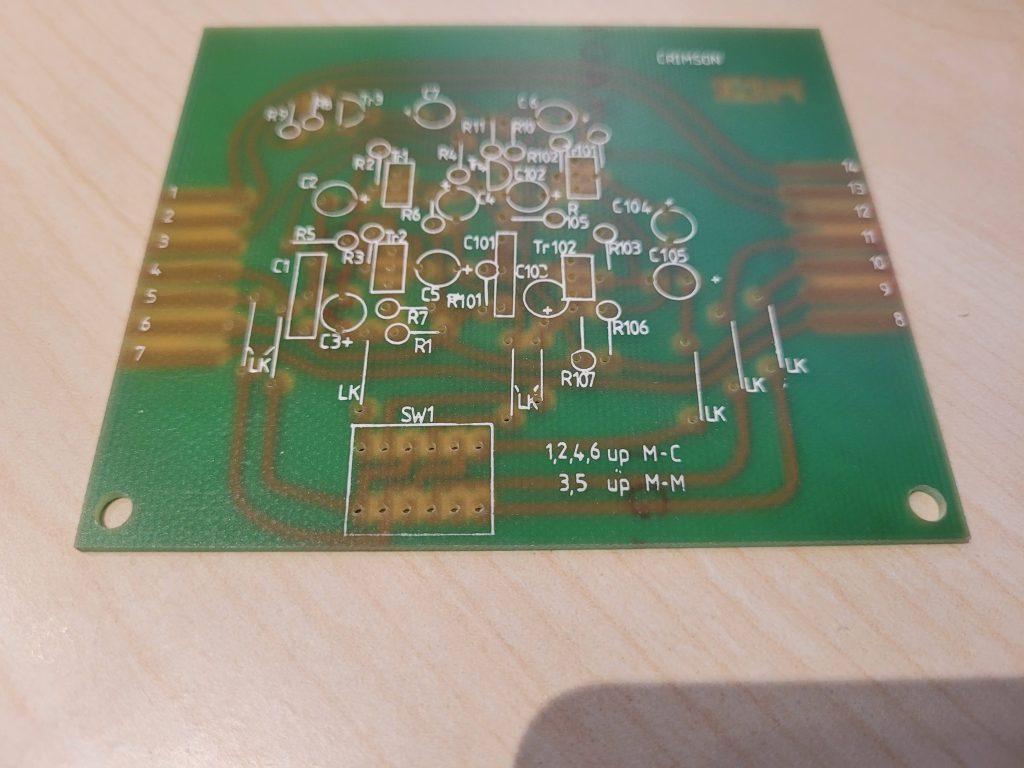These were first produced in 1981. They could powered by the 5 pin DIN to DIN interlink (which also carried the signal) which connected to the 620 power amp. Alternatively, the preamps could operate as standalone units with two PP9 batteries which typically lasted 9 months. There was a factory option to fit a rechargeable battery pack and there was a charger which gave charge only in the preamp “off” mode. When the Ni-Cad pack was fitted the common choice of power amplifiers was two 630 mono blocks. PCBs were ether the early or later CPR2.

Besides the DIN socket, the rear panel had phono sockets for disc (Moving Magnet) and the two line inputs (tuner &CD) as well as the tape input. Mk2 610s had an aux input also.
Version 610C carried two DIN sockets. One was for the DISC input and one was for the power supply input. The wiring for the disc input DIN socket input is shown here in the “phono” section Electronics 2000 | Pin-outs | DIN Connectors . RCA phono sockets made up all other signal connectors apart from the earth post. These later preamps used the PSU Crimson 610 PSU – Brian Powell Audio .
Disc stage sensitivity was 5mV for MM and the line input stage had either 75mV (early version) or 250mV (later version). Extra PCBs (MC2) were fitted on the early 610 for MC disc. The later 610s had an MC PCB (MC3) as standard. This PCB could be switched in or out depending on the requirement. When using MC, the preamp should be situated away from other equipment with mains transformers inside. This is because the stray field from transformers can induce hum.
The preamp had muting circuit to both fade in the volume at power up and instantly go to mute at power down. Connecting the preamp to the power amp could damage the muting circuit if 2-wire signal sources (CD for example) were already connected to the preamp and were powered up. Repair work will harden the preamp against this problem.
Signal switching was done by silver plated rotary switch contacts. These could tarnish and cause crackling over time. Service work will replace these with the gold plated contact ones stocked by BPA.
The volume control was selected for low level channel balance. Sometimes these potentiometer were able to be adjusted to achieve good low level channel balance. Service work can involve fitting the Alps blue manual type, or a remote control motorised potentiometer.
The balance control was an active circuit that both increased one channel whilst decreasing the other. The control was for fine balance and did not mute either channel at full rotation.
The upper switch was able to select a post-recording tape signal. This can be repurposed as selecting a high gain or low gain mode for the line stage.
Service work can add extra line inputs in addition to the tuner and tape.
The 610 was discontinued in 2005 in favour of the replacement the Crimson 710.
Most of the later 610s had an internal power supply which was just a rectifier and two large capacitors. It can reconfigured to give a quieter supply which does result in lower hum on the MC input.
MC/MM switching.
The preamp uses a low voltage supply and is safe for the end user to open. Two M4 hex socket screws can be removed from the bottom side of the cover. This will allow the internal chassis to slide out. The MC PCB is smaller of the two nearer to the rear panel. The pcb legend has the instructions “3,5 up M-M”. The switch bank SW1 can be operated with a small screwdriver to do the following:-
- push all the sliders down
- lift the sliders 3 and 5 (numbered left to right)
- the disc stage is now moving magnet (MM).
Occasionally these switches may not always connect despite being gold plated. In these cases moving them up/down a few times will do the job.
When refiiting the cover there is correct way to get the front panel inset looking right.
